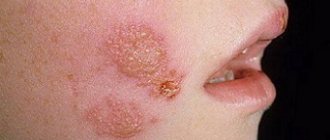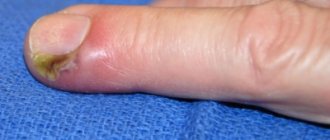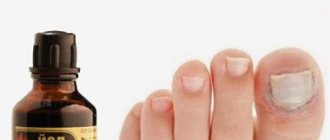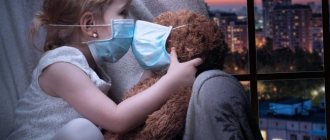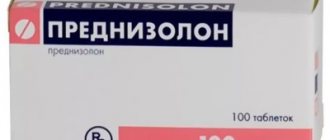Dermatovenerologist
Khasanova
Alina Rashidovna
9 years experience
Make an appointment
A common purulent-inflammatory skin disease of an infectious type, the causative agent of which is bacteria of the genus streptococci, is called streptoderma. This infection accounts for up to 40% of dermatological diseases characterized by the presence of lesions associated with the formation of pustules. In about a third of cases, the disease is severe and leads to temporary disability for the patient.
Nature and causes of skin lesions
The disease primarily affects smooth areas and skin folds, with lesions prone to peripheral growth. Typically, the disease does not affect the sebaceous and sweat glands, hair follicles. The localization of lesions can be on any part of the body - on the skin of the extremities, face and scalp, torso, groin or gluteal fold, etc.
The infection affects people of all ages, and in adults it occurs most often among workers in the construction, transport, metallurgy and mining industries, for whom it is often considered an occupational disease. Streptococci in an inactive state are present in the bodies of the vast majority of people, but the most common causes of streptoderma in adults are:
- reduced immunity combined with massive transmission of infection from a sick person;
- minor skin injuries that contribute to disruption of its barrier function;
- dysfunction of the central nervous system due to stress or fatigue, leading to decreased immunity, deterioration of tissue trophism and blood circulation;
- the presence of a chronic endocrine disease, which increases the risk of developing purulent-inflammatory processes;
- taking certain medications that reduce the body's resistance to streptococcus;
- disturbances in the composition of the intestinal microflora due to poor nutrition, leading to inhibition of the function of intestinal immune cells;
- failure to comply with personal hygiene rules, which creates favorable conditions for the growth of bacteria.
In children, streptoderma most often develops in the preschool period and accounts for up to 60% of pustular skin lesions. Bacteria are usually transmitted through household means; the development of infection is facilitated by the presence of small wounds, abrasions or scratches, and insect bites.
Forms of the disease
Adults tolerate streptoderma more easily than children, especially when they do not start its treatment and do not use folk remedies, but immediately before the appearance of the main symptoms, they immediately go to a medical center.
The most common forms of this disease are the following:
- bullous,
- non-bullous,
- dry streptoderma of the face (lichen simplex),
- streptoderma of the deep layers of the skin.
In general, streptoderma in adults is much easier than in children. For this reason, it is quite rare to prescribe antibacterial drugs orally, and treatment is mainly used locally. The duration of conventional treatment is no more than 3 weeks.
Manifestations of the disease
Streptococci enter the body through minor damage to the skin and mucous membranes and begin to actively multiply, releasing toxins and protective factors from immune cells into the surrounding tissues. 7-10 days after infection, the patient’s body develops a general reaction to the infection in the form of increased body temperature, malaise, muscle pain and headaches. But the main symptom of streptoderma is the appearance of characteristic rashes on the skin, accompanied by itching. The appearance and localization of skin manifestations are determined by the current clinical variant of the disease.
- Streptococcal impetigo is small blisters with clear liquid, which then becomes cloudy and transforms into pus. After a few days, yellowish-red crusts with a loose structure appear in their place. The number of blisters increases, the spots of the affected skin increase in size, crusts are located in the center of each spot, and fresh blisters are located along the edge against the background of swollen skin.
- Zaeda is a slit-like erosion of the skin that forms in the corners of the mouth. It looks like a crack surrounded by flaking pieces of skin and yellow crusts. This is one of the most difficult forms of the disease to treat, since the affected area is additionally injured while eating or talking.
- Panaritium is a horseshoe-shaped inflammation around the nail plate of the finger. The skin acquires a pink-bluish tint, swells, peels off along the edge of the cuticle, and pus is released from under the nail fold when pressed.
- Diaper rash is a type of streptoderma, the symptoms of which most often appear in people with type 2 diabetes, obesity, hypercortisolism, or against the background of seborrheic dermatitis. The disease is localized mainly in the natural folds of the skin - between the buttocks, in the groin area, in the armpits, behind the ears, under the mammary glands, etc. Skin damage is promoted by intense sweating and maceration of the stratum corneum of the skin, a bright red erosive spot and cracks appear in the depths of the fold. The spot constantly gets wet, causing burning and itching.
- Acute diffuse streptoderma is localized mainly on the skin of the legs, around infected wounds, burns or fistulas. Affected areas with a weeping surface and yellow crusts border the injured area. The infection is accompanied by swelling of the extremities and hyperemia, and complications often develop in the form of inflammation of the lymph nodes.
- Lichen simplex appears mainly on the skin of the face in the form of a bright pink rash with clearly defined boundaries.
- Ecthyma is a severe form of the disease with penetration of the purulent process deep into the tissue. An ulcerative-necrotic formation forms at the site of the skin lesion, and after healing a scar remains.
If left untreated, the infectious inflammatory process spreads to other parts of the body.
Are you experiencing symptoms of streptoderma?
Only a doctor can accurately diagnose the disease. Don't delay your consultation - call
List of the best medicines
The tendency of adults to choose their own medications can play a cruel joke on them. If streptoderma is not treated for a long time, the infection will finally take hold in the body. This means that the disease can become chronic. Then blisters and spots on the cheeks, torso, arms or legs will bother the person on a regular basis.
The development of a chronic form is especially likely in persons with varicose veins, diabetes mellitus, and blood vessel diseases.
We do not recommend choosing a drug without taking into account the opinion of a professional dermatologist with a license to practice medicine - sometimes charlatans and healers try to intervene in the matter.
Their methods can cause acute adverse reactions in allergy sufferers. But you should know which medications will most likely help in treating streptococcal infections:
| Type of medicine | Name | Main active ingredient | Manufacturer country |
| Oral drug | Anaferon | Affinity purified antibodies to human interferon gamma | Russia |
| Oral drug | Tavegil | Clemastine | Russia |
| Antibiotic | Amoxiclav | Amoxicillin | Austria |
| Antibiotic | Azithromycin | Azithromycin | Russia Ukraine |
| Ointment for topical application | Sulfuric ointment | Sulfur | Russia |
| Ointment for topical application | Zinc ointment | Zinc oxide (Zinci oxydum) | Russia Ukraine |
[media=
https://youtu.be/PeDHshkHy1A
]
Of course, the drugs from the table are not enough to completely restore the skin with streptoderma. In parallel with their use, you need to smear the crusts with disinfectants. It is recommended to apply bandages with Baneocin or Levomekol to the erosion sites. You can also wipe the affected areas while changing them with boric alcohol or lubricate them with fucorcin. But you should understand the features of the drugs from the above list. They are the ones responsible for treating the disease, and not for relieving symptoms or creating unfavorable conditions for streptococcal infection.
Anaferon
Anaferon is an effective oral pharmaceutical that helps with acute respiratory viral infections, influenza and other bronchial diseases, complications from colds, herpes infections in a chronic condition. It is prescribed for the treatment of people with immunodeficiencies, as well as as part of complex treatment for bacterial infections. It is thanks to the latter function that it is suitable for those who suffer from streptoderma. The advantage of the medicine is that it is suitable for both children and adolescents, as well as adults. We must remember its characteristics:
- produced in the form of sublingual tablets;
- depending on the severity of the lesion, take from three to six tablets per day;
- the drug will cost 236-367 Russian rubles.
Contraindications to the use of Anaferon include pregnancy, lactation or individual sensitivity to any components of the composition. When taken by those who are not included in the described categories of patients, adverse reactions are rare. But mild allergies or headaches are possible, which disappear in just a few days.
Tavegil
Tavegil copes well with the treatment of allergic and pseudo-allergic diseases. It protects the body during blood transfusions and the administration of contrast agents. The medicine also relieves angioedema and helps as an additional remedy in the fight against anaphylactic shock. Tavegil helps relieve inflammation and swelling near streptoderma lesions, improves blood circulation and, accordingly, reduces treatment time. It is suitable for streptoderma in any location, including on the nose and face. Brief information about Tavegil is as follows:
- Available in the form of a solution for intravenous and intramuscular administration or in the form of tablets;
- adults should receive two milligrams or two milliliters per day, depending on the variety;
- This histamine receptor blocker costs 219-386 rubles; it is cheaper in social pharmacies.
Tavegil is prohibited for children under one year of age, people with hypersensitivity, pregnant and lactating women. It is dangerous to give it in parallel with taking MAO inhibitors, if you have fructose intolerance or respiratory diseases. Often those who use Tavegil in the treatment of dermatological diseases are plagued by weakness, drowsiness, sedation, shortness of breath and an acute feeling of fatigue even after a long sleep. Therefore, Tavegil is not recommended for those whose professional activities involve a high level of mental stress or attention.
Amoxiclav
Amoxiclav helps with infectious and inflammatory diseases. Moreover, they can manifest themselves in all organ systems; the medicine still helps eliminate the symptoms and destroy the cellular structure of the pathogens. In case of streptoderma, this antibiotic reduces the population of the pathogen in the patient’s blood. Remember, that:
- the medicine is distributed in pharmacies in the form of tablets and powder for diluting a suspension;
- the maximum dose for an adult patient is six grams, but it must be adjusted according to indications;
- the approximate cost of the antibiotic is 110-799 Russian rubles.
Amoxiclav should not be prescribed for lymphocytic leukemia, infectious mononucleosis, jaundice or previous liver diseases. It poses a danger if you are highly sensitive to drugs from the penicillin group or if you are intolerant to the components. When taking this antibiotic, there is a risk of encountering the following side effects: itching, lack of hunger, vomiting and nausea, diarrhea, hives, swelling of the extremities. However, the likelihood of such symptoms occurring with the correct dosage is minimal.
Azithromycin
Azithromycin, regardless of its release form, is used in the treatment of infections of the respiratory system, soft tissues and skin. It helps eliminate scarlet fever, borreliosis, diseases of the duodenum and stomach, which are provoked by Helicobacter pylori. After a week of use, this drug almost completely destroys streptococcal infections in the patient’s blood. Since the pathogen is no longer present, the crusts and bubbles that become wet from the discharge begin to gradually disappear. Do not forget about the features of Azithromycin:
- the drug is sold in the form of capsules and tablets with a digestible coating;
- the dosage regimen depends on the form of release, the severity of streptoderma and the individual characteristics of the body;
- prices range between 44 and 231 rubles; the best prices can be found in online stores.
The medicine is contraindicated in case of intolerance to macrolide antibiotics. It is not absorbed by those who suffer from severe pathologies of the liver and kidneys. Also, the drug is not used in pediatrics. The most common side effects from the use of Azithromycin are diarrhea, decreased concentration, weakness, headaches or real migraines. In approximately 1% of cases, convulsions, urticaria, photosensitivity occur, and previously recorded chronic diseases worsen. Side effects usually occur in those who take more than the recommended dosage.
Sulfuric ointment
Sulfur ointment is often prescribed by dermatologists. It is inexpensive, but manages to help with most skin diseases. Standard indications for use are psoriasis, lichen, seborrhea, acne, scabies, mycoses of various types and sycosis. Treatment of streptoderma in adults with sulfur-based ointment is also possible: it prevents complications and heals the external manifestations of the disease. But, before using it at home, you need to remember some characteristics. And, most importantly, about the schedule of application to the affected areas of the skin:
- produced exclusively in the form of a thick yellowish ointment;
- Apply liberally to streptoderma spots about two or three times a day;
- the price for a simple sulfur ointment starts from 24 rubles.
Contraindications for use are based on the fact that sulfur - that is, the main component of the ointment - has a noticeable irritant effect. Patients with sensitive skin experience swelling, hives, and an increase in red spots. Therefore, it is not recommended to prescribe Sulfur ointment if the patient is prone to allergic reactions or has not reached three years of age.
Zinc ointment
Indications for the use of Zinc ointment in medical practice are minor sun or thermal burns, dermatitis, diaper rash, scratches, eczema. The medicine also helps in the treatment of acne and minor rashes on the face. For streptoderma, this medicine promotes healing and painless disappearance of blisters. And if dry crusts have already formed in their place, treatment with Zinc ointment will help remove them from the skin faster. The advantage of the ointment is that it can be used anywhere, including in the hair. It is necessary to remember the characteristics of this pharmaceutical product:
- is available only in the form of a thick ointment in jars from 10 to 25 milliliters;
- you need to smear the damaged areas twice a day until the skin is completely healed;
- The minimum cost of one tube is 23 Russian rubles.
The use of Zinc ointment is prohibited in case of hypersensitivity to the components of the medication, or in case of purulent diseases that appear near the treatment site. Potential side effects include skin itching, flushing, and temporary skin redness or irritation. You must be careful not to get the product on your mucous membranes or in your eyes.
After applying Zinc ointment, dermatologist patients regularly complain of unbearable itching.
Obviously, the likelihood of an overdose of ointment is negligible. But if for some reason it gets into the mouth or inside, the patient will experience diarrhea, vomiting, or even prolonged cramps. There is no single way to cure, so urgent symptomatic therapy and medical intervention are required. Perhaps even an ambulance.
Diagnostic methods
To diagnose streptoderma, the doctor does not limit himself to examination and history taking, since external signs of the disease can easily be confused with other skin infections. To obtain accurate data, the patient is prescribed:
- microscopic examination;
- bacterial culture is the most informative research method, which allows not only to detect the causative agent of infection, but also to establish its pathogenicity, and also to check how sensitive it is to antibiotics.
Both tests are prescribed only if the patient has not used antibiotics or other medications. The patient may need to consult an endocrinologist if he has diabetes or is suspected of having this disease.
Conclusions about the treatment of streptoderma
Treatment of streptoderma is carried out not only locally. It is necessary to treat the affected areas and at the same time take the necessary medications internally. Antibiotics, quick topical ointments and tablets that boost immunity or relieve inflammation from the sites of the disease are usually used. Sometimes procedures, traditional methods or dressings with antiseptic ointments are added to them. In any case, it is important that the therapy is supervised by a doctor. Self-medication and incorrect selection of medications can lead to an exacerbation of the disease or its transition to a chronic form.
Elimination of skin lesions
If the disease has not become severe, treatment of streptoderma is carried out on an outpatient basis. If there are severe symptoms - deep erosion and necrotization of tissue, inflammation of the lymph nodes, etc. - the patient is admitted to a dermatological hospital. Therapy consists of:
- proper skin care, excluding washing with soap and water, to avoid spreading the disease to other areas;
- external treatment of affected areas with aniline dyes, application of ointments with antibiotics and keratolytic compounds;
- taking antibiotics in case of lymphangitis and severe intoxication;
- specific immunotherapy aimed at combating staphylococcal infection.
In addition, complex vitamins may be additionally prescribed, and at the end of the course of antibiotics, probiotic preparations may be prescribed to restore the intestinal microflora.
Prevention of streptoderma involves frequently washing the skin with soap and water. Research shows that soap solution destroys up to 95% of streptococci on the surface of the skin. Compliance with hygiene rules is especially important after contact with a person suffering from a pustular rash.
Material and methods
At the screening stage, 55 patients were observed. Before prescribing systemic therapy, all patients underwent bacterial culture for sensitivity to minocycline
. After the study, sensitivity was detected in 46 (83.6%) patients, who made up the observation group.
Subsequently, 46 patients aged from 18 to 67 years were under our observation - 24 (52.2%) men and 22 (47.8%) women. In 25 (54.3%) patients, the process arose for the first time (duration up to 2 months) and was of an acute inflammatory nature, in 21 (45.7%) it lasted more than 2 months (chronic inflammation). The following clinical forms of pyoderma were diagnosed: vulgar impetigo - 6 (13%) cases, boils - 10 (21.7%), periungual phlyctena - 9 (19.6%), pyoderma of large folds - 11 (23.9%), erysipelas - 10 (21.7%) (Fig. 1).
Rice. 1. Clinical forms of pyoderma in patients under observation.
Initial dose of Minolexin
was 200 mg (2 capsules of 100 mg or 4 capsules of 50 mg), then patients took 100 mg (1 capsule of 100 mg or 2 capsules of 50 mg) every 12 hours (2 times a day). The drug intake was independent of food intake. The duration of antibiotic therapy was 7 days, for erysipelas - 10 days. Depending on the severity of the process, patients used aniline dyes and antiseptic drugs as topical therapy.
conclusions
Thus, Minocinclin
has a wide spectrum of antimicrobial action, high bacteriostatic activity against infections sensitive to it, a minimum of side effects and a convenient dosage regimen.
Consequently, the drug meets modern requirements for rational antibiotic therapy and can be recommended in clinical practice for the effective treatment of various clinical forms of pyoderma. Recommended course: the initial dose of Minolexin
was 200 mg (2 capsules of 100 mg or 4 capsules of 50 mg), then 100 mg (1 capsule of 100 mg or 2 capsules of 50 mg) every 12 hours (2 times per day).
Taking the drug does not depend on food intake. The duration of antibiotic therapy is 7 days, for erysipelas - 10 days. The drug has a good safety profile, which is confirmed by the absence of significant negative dynamics in clinical blood and urine tests and biochemical blood tests. Minocycline
is characterized by high lipophilicity and dermatotropism, allowing it to achieve optimal therapeutic concentrations inside the inflammatory elements of the skin and the absence of increased photosensitivity .
The authors declare no conflict of interest.
1e-mail 2e-mail
![Folliculitis [13]](https://dlradio.ru/wp-content/uploads/follikulit-13-330x140.jpg)
